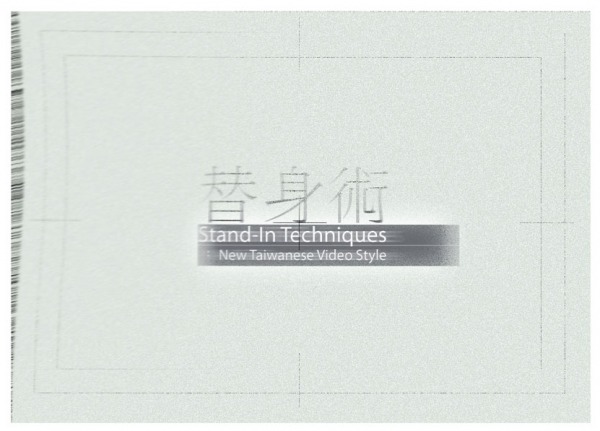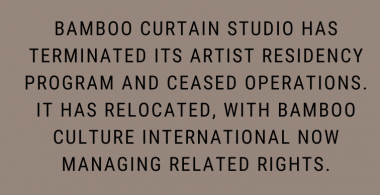- Login to post comments
 「替身術」-台式錄像展
「替身術」-台式錄像展
策展人:吳達坤 & 非常廟藝文空間策展團隊
參展藝術家:姚瑞中、蘇匯宇、陳敬元、陳萬仁、吳達坤 、杜佩詩。
展期:2010年11月 12 日 - 12月 10日
開幕:2010年11月 12 日 5-8 pm
地點:美華藝術協會 紐約456畫廊 紐約百老匯大街456號3樓
「替身術」觀察 ---台灣影像新世紀。文/ 吳達坤
自從上世紀90年末以降,隨著政治氛圍轉變、媒體和全球化盛行、電訊科技蓬勃發達,台灣這個科技之島的影像創作一直展現出新的能量。藝術家面對對社會現實的投射與自我感知的異變,進而轉化處理當代社會中身體感消散的創作過程面對身體與空間政治的幻化主體模式出現。這已然是台灣藝術家作品一個明顯的表徵,我稱這樣幻化身體的過程為之「替身術」。
進一步說明,將個人經驗與虛幻、虛擬的各樣複合物並存組成為另一種「新的自我與自我意識」的產物。藝術家將身體轉化作為一種意識形態的隱喻場所。這樣的「身體觀」與「大我」意識也逐漸轉化而為分散、多重、無實體感的「幻化身體」和「小我」。 想想,我們是正處在一個除了小寫「i」的存在感外,大寫的「I」已不覆存在,熟知的一切都漸漸崩解為「身外之物」。 未來,人的身體可以透過網路無限幻化延伸,我們都是行在光前端的時空旅人。
透過各種「替身術」本展的台灣藝術家提出許多「身體」的虛幻化、分身化的可能。 這已普遍存在我們的日常生活中與社會集體的意識網絡結合在一起,成為了當下的「新現實」。
1. 政治幽魂:姚瑞中、陳敬元
2. 恐怖分子與國際主義: 吳達坤
3. 浪漫術: 蘇匯宇
4. 借物抒情: 陳萬仁
5. 操偶術:杜佩詩
在東方,我們看到台灣藝術家完美而準確地擊中了後資訊時代人們所感知的自我標的。
“Stand-In Techniques”- New Taiwanese video Style
Curator: Wu Dar-Kuen & VT Artsalon
Artists: Yao Jui Chung, Su Hui Yu, Chen Ching-Yuan, Chen Wan-Jen, Wu Dar-Kuen, Tu Pei-Shih.
Date:2010.11.12-12.10
Opening Reception: 2010.11.12 5 - 8pm
Location: Gallery 456 456 Broadway,3rd Floor New York,NY 10013
Observations of “Stand-In Techniques” – Taiwan Video in the New Century.
By Wu Dar-Kuen
Since the 90s, towards the end of the last century, with the changes in the political atmosphere, the prevalence of the media and globalization, as well as the boom in telecommunications technology, video creativity in the island of technology, Taiwan, has continuously shown new energy. Artists face the projection of social reality and the mutation of self-perception. They go on to transform the creative process of contemporary society’s dissipation of the body, and face the appearance of the metamorphosis model of body and political space. This is a characteristic of the works created by Taiwanese artists. I call this process of body metamorphosis “Stand-In Techniques.”
Further explanations describe this process of taking personal experiences and various fantasy and virtual composites that coexist to create another product of “new self and self-awareness.” Artists transform their bodies into an ideological and metaphorical place. This type awareness of “body concept” and “big I” slowly transforms into scattered, multiple, and non-physical “body metamorphose” and “small i.” Pondering about this matter, we are currently in a state where the lowercase “i” exists but the uppercase “I” has ceased existing, and everything we regard as familiar has slowly crumbled to become merely “worldly possessions.” In the future, human bodies can metamorphose infinitely through the Internet, and we are all space-time travelers walking in front of the light.
Through a variety of “Stand-In Techniques,” Taiwan artists propose many possibilities for the fantasizing and cloning of human bodies. This has been pervasive in our daily lives and has combined with the collective consciousness of society, thus forming a “new reality.”
1. Political Humor: Yao Jui Chung and Chen Ching-Yuan
2. Terrorists and Internationalism: Wu Dar-Kuen
3. Romanticism: Su Hui Yu
4. Expressing Through Other Objects: Chen Wan-Jen
5. Puppet Manipulation: Tu Pei-Shih
In the East, we see Taiwanese artists perfectly and accurately hitting people’s point of self-perception in the post-information age.

